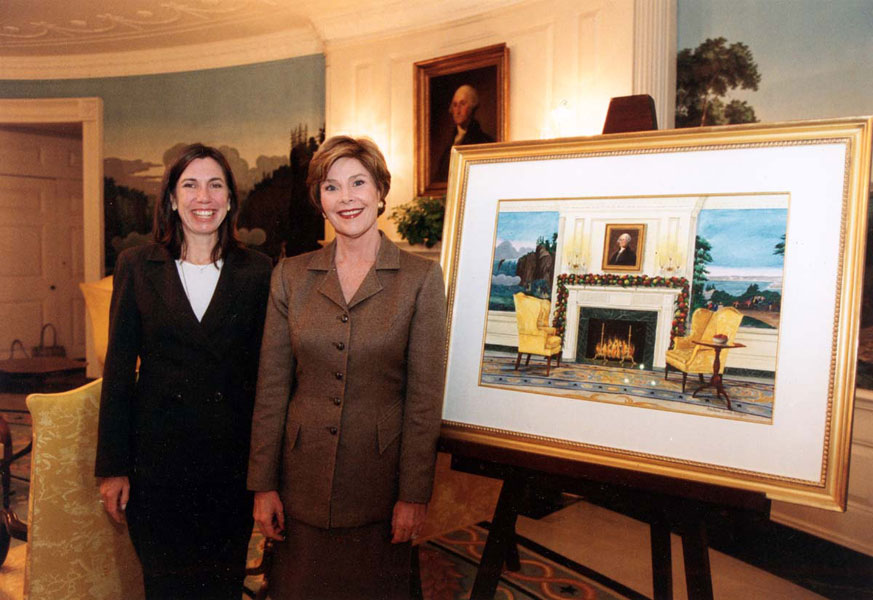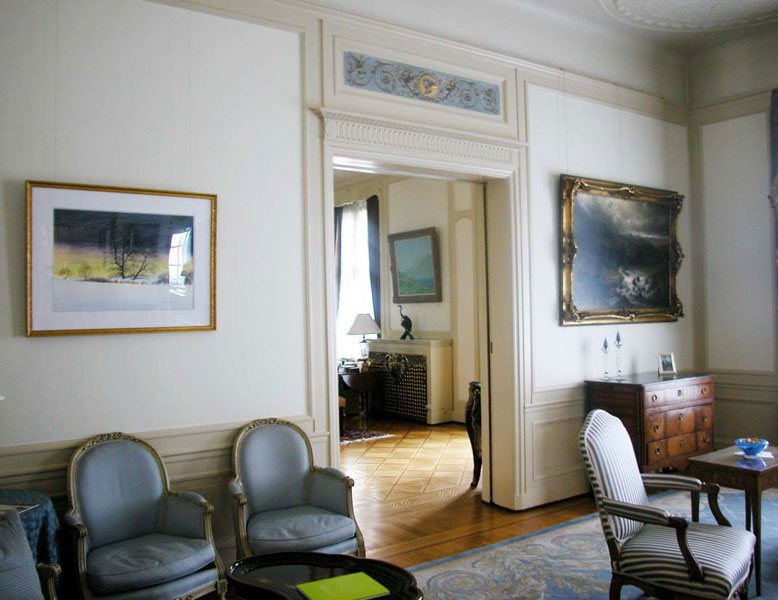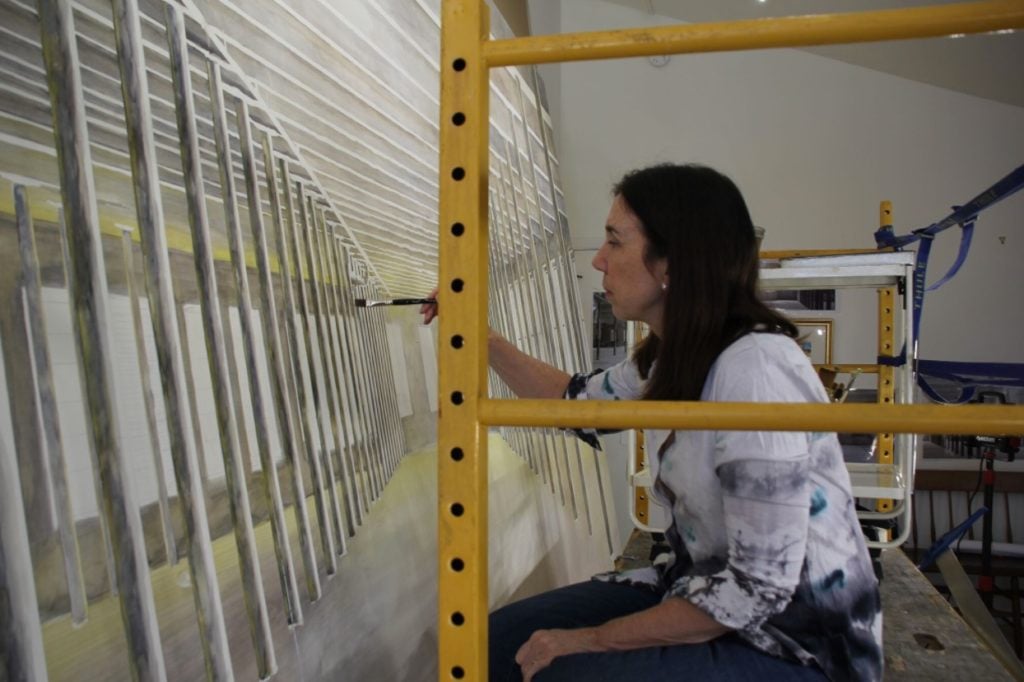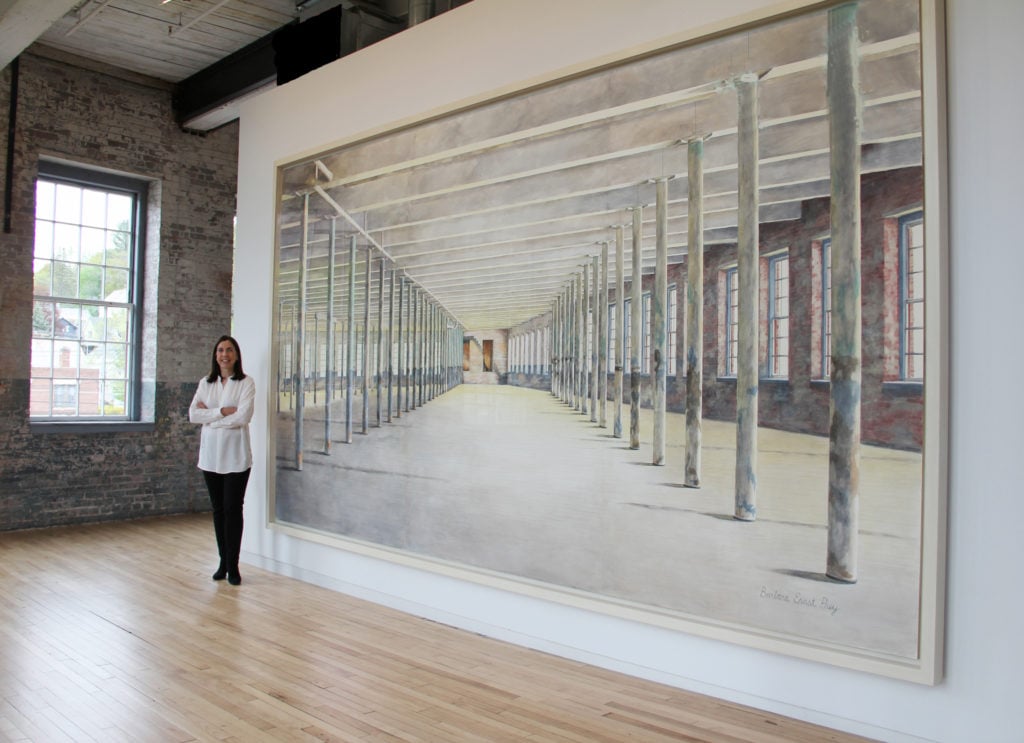The National Council on the Arts is a 14-person advisory committee that reports to the chairman of the National Endowment for the Arts. All its members are appointed by the President of the United States, and appointees are selected for their knowledge and expertise of the arts, and their distinguished record of service in their respective fields.
Barbara Prey is the only visual artist on the committee—she was appointed by then-President George W. Bush. Working primarily in the unforgiving medium of watercolor, Prey built a career by selling her delicately composed works of landscapes, seascapes, and various scenes of American life to the US government and high profile private collectors including Orlando Bloom and Tom Hanks. Her works hang in over 100 US embassies around the world. She is one of only two living female artists who has work in the White House permanent collection, and has been commissioned by NASA on numerous occasions.
Recently Prey was commissioned by MASS MoCA to create a monumental watercolor—said to be the world’s largest—for the museum’s newly inaugurated Building 6. The completed work hangs at the museum alongside works by Louise Bourgeois and Robert Rauschenberg. And she has an ongoing show at her Maine gallery featuring sketches and studies of the MASS MoCA commission.
Prey’s career trajectory illustrates an alternate path to success outside of the traditional gallery system, benefiting predominately from the Art in Embassies program—a global initiative that sought to exhibit artworks from many disciplines in embassies and consulates around the world.
In her nine-year tenure as the only working artist on the National Council, Prey has developed a unique understanding of the inner workings of the NEA. Recently, artnet News spoke to the artist about how she became the US government’s go-to artist, and what she thinks will happen with he NEA under a Trump administration.

Barbara Prey and First Lady Laura Bush at the presentation of her work in the White House collection in 2003. Photo: courtesy of the artist.
You’ve developed a close relationship to the US government through the Art in Embassies program, the White House, NASA, and your role on the advisory board of the NEA. How did that all come about?
I established myself in the nonpartisan government agency art commission circuit and build a relationship with the US State Department’s Art in Embassies program (AIE), when a handful of Ambassadors started to collect my work. The Ambassadors to Norway, France, Spain, and Czech Republic all collected my artwork and requested my artwork for exhibitions at their embassies.
Then in 2003, I received a phone call out of the blue from NASA. The agency commissioned me to paint four paintings for their collection. This is unusual for a single artist, but NASA was familiar with my work though AIE. Laurie Anderson and I were the only two artists commissioned by NASA that year. I’m also one of the only two living female artists in the White House permanent collection. The [Bush] administration was also familiar with my work through AIE, and a series of paintings I made about September 11th.
The appointment to the National Council on the Arts, the advisory board to the NEA, was a similar unexpected phone call. To this day I have no idea who actually recommended me to be nominated by President Bush. I think it was most likely AIE. The process was very complex and I had to undergo a one-and-a-half-year vetting process administered by five FBI agents.
There’s been a lot of focus on the NEA since Trump threatened to cut funding, but little is known about the inner workings of the organization. Can you describe your role within the National Council on the Arts, and give us some insight into the dialogues taking place at the meetings right now?
The National Council on the Arts is the advisory body to the Chairman of the NEA, made up of members appointed by the President of the United States.
The members are selected for their knowledge, expertise and interest in the arts and they must have distinguished records of service and achievement in the arts. We’re appointed based on geography to be representative of the country’s regions. I was appointed from New York.
The vetting process is that of an Ambassador or cabinet member. I think the FBI conducted close to 50 interviews for my vetting. The council votes on all the art grants given by the NEA and nominates the annual National Medal of Arts recipients.
Right now the NEA is going forward as usual. The NEA is fully funded through 2017 and continues to make 2017 grant awards. We continue to accept grant applications for the fiscal year of 2018 at the regular deadlines and will continue to operate as usual until a new budget is enacted by Congress. That said, the President’s fiscal year 2018 budget proposes the elimination of the National Endowment for the Arts, with a request for $29 million intended to be used for the orderly shutdown of the agency.
Something that I found helpful from our last meeting is that the current budget request is a first step in a very long budget process of 24 steps. I’m optimistic, and I hope I am correct, that when the budget gets further along the negotiations, there will be large Democratic as well as the Republican support, because there are many Republicans who advocate for the NEA. This isn’t the first time the NEA faced the possibility of elimination [the Reagan administration also had plans to cut the agency]. The NEA just celebrated its 50th anniversary and I am hopeful that it will be around for many more years to come.
Having said that, the NEA itself cannot engage in advocacy, so it’s important that individuals and organizations continue to advocate for the NEA.

Barbara Prey’s work at the US Embassy on Oslo, Norway. Photo: courtesy of the artist.
Based on your experience, to what extent does government have a responsibility to support the arts?
I am an advocate for the arts and I strongly believe, as a visual artist, that government has a role in supporting the arts, which is vital to our nation and humanity. One of the benefits of being appointed to the National Council on the Arts is reading and voting on all the grants, so I get to see the diversity of art forms in America that we support. Each administration and chairman of the NEA has specific goals and programs that they initiate.
As I mentioned earlier, the NEA can’t advocate for itself, as it is a government agency, but other arts organizations can. The NEA is very good about noting how the arts contribute to our economy, which is a good argument for Congress to continue to support the arts. The arts and culture sectors account for $742 billion or 4.2 percentof the GDP, and add millions of jobs to our workforce. There are more than two million full-time artists and nearly five million arts-related jobs. Part of the NEA’s role is to make sure all Americans have access to the arts no matter where they live, so all 435 congressional districts benefit from NEA grants.
What is your opinion on the current administration’s policy towards the arts?
I’m disappointed in the possibility of the agency’s elimination; however, after our June meeting, I am very optimistic about its future.
You’ve been described as a global ambassador for American art. How do you go about synthesizing the diversity of the artistic practice in America for an international audience?
I am fortunate to see the incredible diversity of artistic practices around the country—from traditional to non-traditional arts. American Art is not monolithic, and there’s such a variety of disciplines, ideas, and voices that the world responds to.
I am a huge supporter of the NEA, in particular because of the meaningful impact its 50 years of awarding grants has had on so many arts organizations, artists, and communities around the country.

Barbara Prey working on her Mass MoCA commission on site. Photo: courtesy of the artist.
Your artwork featured in Mass MoCA’s Building 6 is said to be the world’s largest watercolor. Can you describe how you approached this commission, your process, and the unique challenges associated with the medium?
MASS MoCA commissioned me to paint a monumental watercolor measuring 8 by 15 feet in their newly renovated. Building 6. The completed painting also shares a floor with a collection of Louise Bourgeois sculptures and works from Robert Rauschenberg.
I’ve been painting in watercolor for over 45 years, so the challenge and opportunity to open up new, innovative, and groundbreaking possibilities with the medium, on a monumental scale, was appealing. I wanted to capture the experience of seeing how the natural light flooded the raw, industrial architecture of this disused space.
As the sole visual artist on the National Council on the Arts for nearly a decade, I found the project to be aptly suited to the NEA’s community-based focus; the building’s former life as a textile mill once anchored the community economically, just as it’s incarnation as a museum now does in a cultural capacity.











